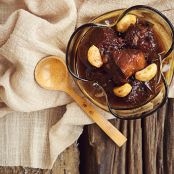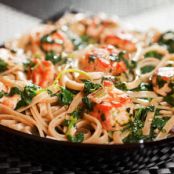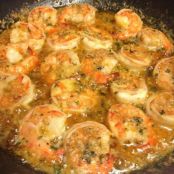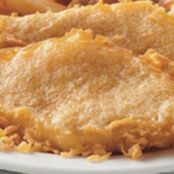Seafood Paella
By á-7018
Author Note: It is best to buy mussels and clams on the same day you wish to eat them. As soon as you get them home, take them out of their bags, and put them in a bowl, with lots of crushed ice. Put this in the fridge. Drain the bowl of any melted ice every few hours.
Ingredients
- 1 1/4 cups of Spanish Bomba rice
- 4 cups of chicken stock (or fish stock)
- 1 glass of white wine (for the paella)
- 1/2 glass of white wine (for the mussels and clams)
- 1 pinch of saffron
- 30 mussels
- 20 clams
- 15 large prawns
- 1/2 onion
- 1 stalk of celery
- 1 fennel bulb
- 2 garlic cloves
- 8 ” chorizo sausage – sliced across ways
- small handful (total) of chopped fresh
- basil and parsley
- olive oil
- lemon wedges
Details
Servings 8
Preparation
Step 1
1. Finely chop the onion, celery, fennel and garlic. Scrub the mussel shells, and debeard. Scrub the clam shells. Peel the shrimp, and de-vein if
required. Discard any mussels or clams that have broken shells, or are open
and don’t close up tight when you scrub them.
2. In a small pan, warm the stock over a low heat.
3. Put the saffron in the white wine, and let it infuse for at least 10
minutes.
4. Heat the paella pan over a medium heat, and add two tablespoons of olive
oil. When the oil is hot add in the onion, celery and fennel. Cook gently
until soft – about 10 minutes. Add in the garlic, and cook for another
minute. Stir in the rice, and let it absorb some of the oil. Add in the
chorizo. Turn up the heat and pour in the white wine. Let this boil for a
minute, and then add in most of the stock. Gently stir.
5. Let this boil gently for 5 minutes. Add in the prawns, and cook for a
further 15 minutes. You will want to gently stir this from time to time, to
make sure everything is heating evenly. If it looks like the rice is
absorbing all the stock too early (before the 15 minutes is up) add a little more in.
6. For authentic paella you want to stop yourself from stirring the dish
during the last half of cooking. Apparently the best paella has a crust on
the bottom of the rice (where the rice is in contact with the pan) – this is only achieved through not stirring.
7. With a few minutes to go in the cooking process, put a large pan over a
high heat. Add in the 1/2 glass of white wine, and get it boiling. When it
has reduced by about half, toss in the mussels and clams. Cover with a tight fitting lid, and turn the heat down to medium-high. These will take about 3 minutes to steam open. You should be able to hear them pop open, and a lovely wiff of the sea will start to come up from the pan. Discard any mussels or clams that haven’t opened.
8. Arrange the bivalves in the paella, sprinkle with the basil and parsley.
and let sit for a few minutes, off the heat for the flavors to meld
together. Serve with the lemon wedges and three forks.
Author Note: A few notes on buying and cleaning mussels and clams:
Author Note: A lot of fishmongers really don’t store mussels and clams well. Mussels should be kept in lots of ice – not just sitting on a bed of them. Take a look at the little buggers. They should be closed. If they are open, looking like they are gasping for their last breath – move on. You can also ask to see the “tag” for them. This will show when they were harvested – and thus how fresh they are.
Author Note: Clams can bet kept on ice for a little bit, but should ideally
be kept in moving water, at a specific salt level.
Author Note: To clean a mussel – first inspect the shell for any visible
damage. If it is cracked, or is open (and doesn’t close when you tap it or
scrub it under running water) discard the blighter. Gently scrub the shell
removing anything that is crusted on. With a firm yank pull off the beard of the mussel (the hairlike bit sticking out the shell join), if one is still attached.
Author Note: To clean a clam simply scrub the shell. Again discard any that
are open or damaged. Clams have much thicker shells than mussels, and the
likelihood of damage is slim.
Author Note: I reckon on about a 10% wastage for mussels – what with damaged shells and all.
You'll also love
-
 Ultra Rich Caramelized Filipino...
3.9/5
(45 Votes)
Ultra Rich Caramelized Filipino...
3.9/5
(45 Votes)
-
 Slow Cooker Salmon Spinach Pasta
3.8/5
(47 Votes)
Slow Cooker Salmon Spinach Pasta
3.8/5
(47 Votes)



Review this recipe